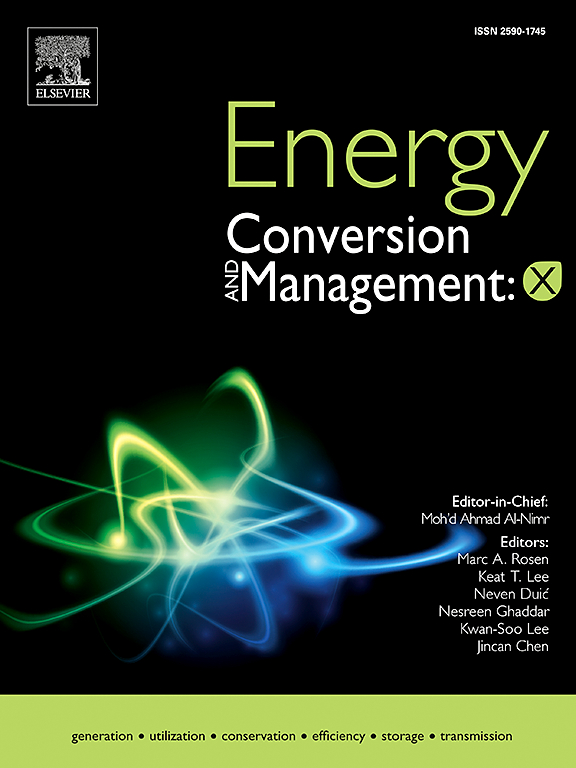Operational implications of transporting hydrogen via a high-pressure gas network
IF 7.1
Q1 ENERGY & FUELS
引用次数: 0
Abstract
Transporting hydrogen gas has long been identified as one of the key issues to scaling up the hydrogen economy. Among various means of transportation, many countries are considering using the existing natural gas pipeline networks for hydrogen transmission. This paper examines the implications of transporting hydrogen on the operational metrics of the high-pressure natural gas networks. A model of the GB high-pressure gas network was developed, which has a high granularity, with 294 nodes, 356 pipes, and 24 compressor stations. The model was developed using Synergi Gas, a hydraulic pipeline network simulation software. By performing unsteady-state analysis, pressure levels, linepack levels and compressor energy consumption were simulated with 10-minute time steps. Additionally, component tracing analysis was utilised to examine the variations in gas composition when hydrogen is injected into the gas network. Five scenarios were developed: one benchmark scenario representing the network transporting natural gas in 2018; one scenario where demand and supply levels are projected for 2035, but no hydrogen was transported by the network; two hydrogen injection scenarios in 2035 considering different geographical locations for hydrogen injection into the gas network; and lastly, one pure hydrogen transmission scenario for 2050. The studies found that the GB’s high-pressure gas network could accept 20 % volumetric hydrogen injection without significantly impacting network operation. Pressure levels and compressor energy consumption remain within the operational range. The geographical distribution of hydrogen injection points would highly affect the percentage of hydrogen across the network. Pure hydrogen transportation will cause significant variations in network linepack and increase compressor energy consumption significantly compared to other case studies. The findings signal that operating a network with pure hydrogen is possible only when it is prepared for these changes.
通过高压气体网络输送氢气的操作意义
长期以来,运输氢气一直被认为是扩大氢经济的关键问题之一。在各种运输方式中,许多国家正在考虑利用现有的天然气管网进行氢气输送。本文考察了输送氢气对高压天然气网络运行指标的影响。建立了具有高粒度、294个节点、356个管道、24个压缩站的GB高压燃气网络模型。该模型是利用液压管网仿真软件Synergi Gas开发的。通过进行非稳态分析,以10分钟的时间步长模拟压力水平、管线包水平和压缩机能耗。此外,组分示踪分析被用来检查氢气注入气体网络时气体成分的变化。开发了五个情景:一个基准情景代表2018年的天然气运输网络;一种情况是,2035年的需求和供应水平预计将达到,但氢气没有通过网络运输;考虑不同地理位置的2035年两种注氢情景最后,一个2050年的纯氢传输方案。研究发现,在不显著影响管网运行的情况下,国标高压燃气管网可接受20%体积注氢。压力水平和压缩机能耗保持在运行范围内。注氢点的地理分布将极大地影响整个网络中氢气的百分比。与其他案例研究相比,纯氢运输将导致网络线路包的显著变化,并显著增加压缩机的能耗。这些发现表明,只有在为这些变化做好准备的情况下,纯氢网络才有可能运行。
本文章由计算机程序翻译,如有差异,请以英文原文为准。
求助全文
约1分钟内获得全文
求助全文
来源期刊

Energy Conversion and Management-X
Multiple-
CiteScore
8.80
自引率
3.20%
发文量
180
审稿时长
58 days
期刊介绍:
Energy Conversion and Management: X is the open access extension of the reputable journal Energy Conversion and Management, serving as a platform for interdisciplinary research on a wide array of critical energy subjects. The journal is dedicated to publishing original contributions and in-depth technical review articles that present groundbreaking research on topics spanning energy generation, utilization, conversion, storage, transmission, conservation, management, and sustainability.
The scope of Energy Conversion and Management: X encompasses various forms of energy, including mechanical, thermal, nuclear, chemical, electromagnetic, magnetic, and electric energy. It addresses all known energy resources, highlighting both conventional sources like fossil fuels and nuclear power, as well as renewable resources such as solar, biomass, hydro, wind, geothermal, and ocean energy.
 求助内容:
求助内容: 应助结果提醒方式:
应助结果提醒方式:


